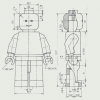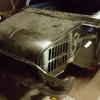Well said Tiger.

New Ball Joints, Adding A Flat Washer Under The Seat

Best Answer Spider , 28 August 2017 - 09:15 PM
As the others have said, there's an issue here and fitting a (soft) washer under the Ball Joint Seat isn't a good idea.
As the joints come in a Hub Set, have you tried swapping parts between this pair?
Are you able to post up a photo of your hub with the Ball Joint Removed? In particular, I'd like to see the bore where the seat fits.
Also, just working off the photo on the Moss web page, those don't quite look like Mini Spares Ball Joints.
Go to the full post
#31

Posted 12 September 2017 - 07:00 AM
#32

Posted 12 September 2017 - 09:14 AM
Thanks guys for the many answers !
We had 15 shims available when adjusting this ball joint. We mounted, and unmounted the ball joint more than 20 times before understanding that with the shims we had we won't be able to get the right thickness that will lead to a nice adjusted ball joint at 100Nm. So we adjusted the torque from 100Nm to 90Nm (not even sure my torque wrench is that precise at those values ...).
Sanding the nut is a bodge fix, and we know that considering what Moke Spider told us about the hub picture. We will check deeply into the hubs and the ball joints this winter, or during spring. The car won't make more than 1000km during that period.
Does it sound too much dangerous to you ?
To Tiger99 :
1. "basic engineering competence" : I feel quite offended as my brother and I are both mechanical engineers ![]() .
.
2. "Following anything except the procedure adequately documented in the Rover manual has killed people": You think at rover on the assembly line they were testing ball joints 20 times ? They read procedure and did what's written on it, which give not that great results (Started my all my adjust with the recommended procedure, all ball joints were totally blocked, no exception). Don't you agree ?
3. "No, it is extremely dangerous to adjust with the torque, so please do not use the car in that condition. You have been given very bad advice by someone lacking some basic engineering competence.": It's not like I put 3Nm instead of 100Nm, moreover when hammering the locking washer to block the nut, I'm 100% sure you lost a good part of that precise torque without knowing how much...
Conclusion :
The real big problem with this critical part is that no one is agree !
You can read about the adjustment : "should be hard to move", "You should be able to push it with a single finger, but it should be a bit hard". The part is awful to adjust, and the required adjustment is a total blur ... so it makes that way harder.
You can read that some lap the ball retainer to reduce roughness between the ball and the nut, other say that it is a dangerous way to go.
etc ... etc ...
Even between the two consecutive answers of Moke Spider and Tiger99 there is contradictions...
The only think I agree here, is that the sanding the nut should not be a permanent solution, and won't be one (I will look for it this winter).
But, there is no way the ball joint problem is a "basic engineering problem" or everyone would be agree on the best way to go for this part.
Edited by Gavroche, 12 September 2017 - 09:15 AM.
#33

Posted 12 September 2017 - 09:31 AM
Sanding the flat of the big nut is not a bodge job, and moke spider never said it was. It is a very good way of getting it spot on.
#34

Posted 12 September 2017 - 09:42 AM
Please guys, don't let this turn in to a personal slanging match - OK? It's only ball joints,,,,,,,
Gavroche - I feel that given your circumstance above, for 1000 - 2000 km it'll be OK. You are aware of the issue with it and if it plays up, you'll know exactly the issue here. While I've suggested it a bodge, I can't see it letting go either. It is not advice I would hand out.
Edited by Moke Spider, 12 September 2017 - 09:43 AM.
#35

Posted 12 September 2017 - 09:57 AM
#36

Posted 12 September 2017 - 10:17 AM
Pete, I hear you on the shimming and yes, I'm pretty sure that the thinnest available is 0.003", however, I've found the torque range given by BMC / Leyland / Rover for these, being from 70 to 80 ft / lb covers more than 0.005", so that's how one gets 'across' the need for smaller than 0.003" shims. Also, the factory allow up to 0.003" play.
Just something to think about ![]()
#37

Posted 12 September 2017 - 11:24 AM
Just to recall the big lines of this topic, it may avoid misunderstanding or misreading.
1. Not enough play in my ball joint, the first measure of play was inferior to the thickness of the lock washer. The measure was 0.7mm of play between bottom of ball retainer and the hub. Lock washer thickness is ~0.9mm.
2. First idea was to increase the height of the ball pin and its seat by putting a flat washer under the seat of the ball joint (height & play increased from ~1mm) and then adjust the ball joint normally.
3. Flat washer is made from a too soft material, may deform fast and causes the ball joint to be blocked (So this solution has been discarded.)
4. Moke Spider asked for a picture of my hub. And told me the hub is clearly damaged under the seat of the ball joint and needs to be changed. We don't have time neither the money to do so right now, so we are looking for a "legit" bodge.
5. My seller advises me to sand the bottom of the ball retainer of at least the .2mm so that the play will be higher than the thickness of the lock washer. And then shim and adjust the ball joint correctly.
6. We sanded the ball retainer, and as we did not find the good stack of shims, we adjusted the torque from 100Nm (advised by constructor) to a 95-90Nm to get a "it is hard but not so much, and you can push the ball joint with your bear hand etc... " ball joint.
What I don't like about sanding the ball retainer is that we have not the machinery to ensure the planeness at the bottom of the nut. Thus it could force not equally on the ball pin, and may result in an unequal wear.
Edited by Gavroche, 12 September 2017 - 11:25 AM.
#38

Posted 13 September 2017 - 08:08 PM
I actually find a set of shims that is marginally tight and then rub the BACK of the small ball seating on a carpenter's oilstone (not having a surface grinder) to increase the clearance very slightly. I have never assembled one that had stiff spots, or anywhere near the maximum 3 thou end float, more like half a thou when I was done. That way, they tend to last for a surprising mileage, some making it to 100k or more.
You can also shim slightly loose and abrade the face of the ball retainer (dome nut) to tighten it, but that is less satisfactory unless you have a surface grinder, because the larger diameter is less tolerant of lack of parallelism.
But in this case at least one joint has been incorrectly manufactured, which is why it is more than likely that it is a bogus and unsafe part, which sadly are abundant these days. which is why I strongly recommend discarding the lot.
Safety critical parts should always be procured from a reputable source, who freely discloses their origin. A brand like Delphi is preferable, if they do ball joints, as they are a mainstream automotive manufacturer with rigorous quality control in everything that they do. even in their Chinese factories. Unbranded things in a plastic bag, which I have seen, are just asking for trouble. (By the way I don't work for Delphi now, maybe will do so again later, and I was nowhere near the balljoint part of the business, so I don't get commission for flogging their products.)
Is a human life, or maybe several lives, worth the cost of a new set of properly branded ball joints?
#39

Posted 14 September 2017 - 07:04 AM
#40

Posted 14 September 2017 - 09:10 AM
Thanks for giving me a good brand of ball joints. This will definitely be useful later on.
I may have not buy the DELPHI ball joints, but as said before the ball joint is not the problem as my hub is worn under the seat of this ball joint.
We did sand the nut to make it work for 1000km max, as we will change for new hubs this winter or this spring.
1 user(s) are reading this topic
0 members, 1 guests, 0 anonymous users















